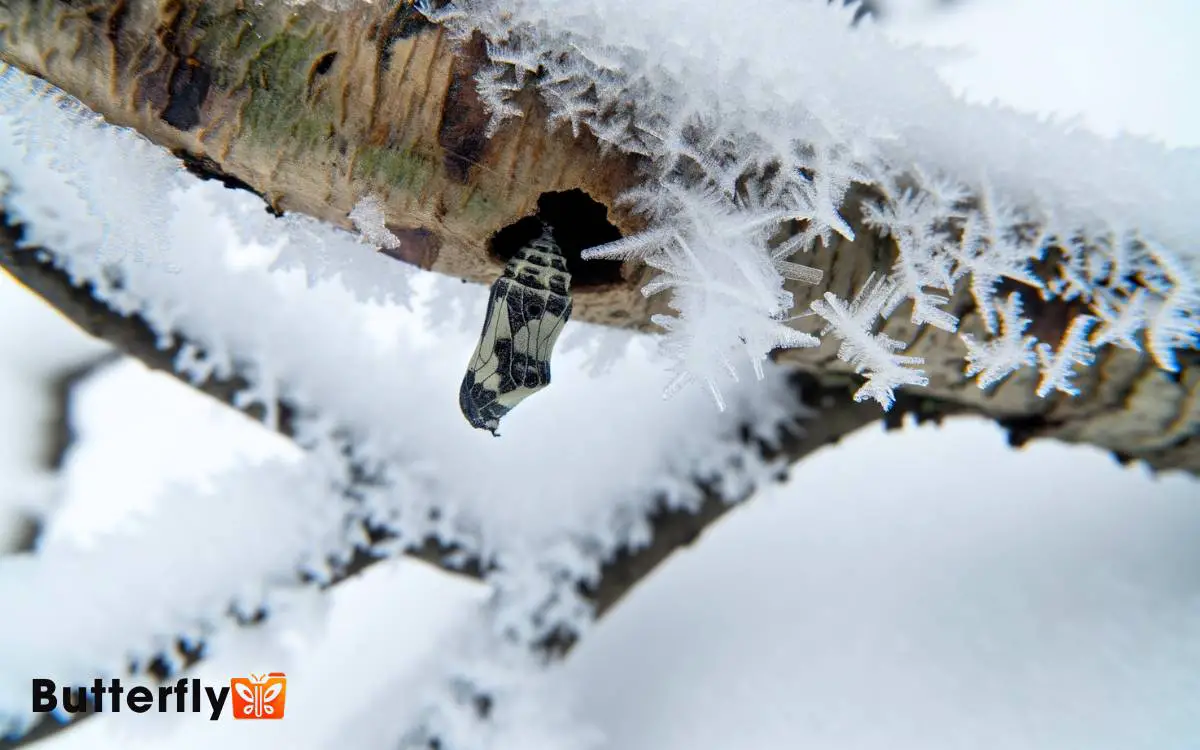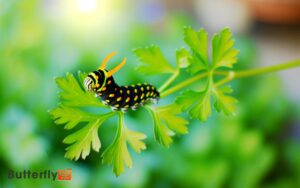How Do Swallowtail Butterflies Overwinter? Explained!
Swallowtail butterflies overwinter by entering diapause, a state of dormancy triggered by shorter daylight and lower temperatures. They accumulate cryoprotectants like glycerol to prevent ice formation in tissues.
Caterpillars form a chrysalis with a protective silk covering, often selecting sheltered microhabitats such as leaf litter or tree bark crevices.
Diapause conserves energy during food-scarce months, while antifreeze proteins enhance cold tolerance. Ideal overwintering temperatures range from -2°C to 10°C. These adaptive strategies secure their survival through winter and successful emergence in spring.
For a deeper understanding of their fascinating lifecycle and conservation efforts, continue exploring.

Key Takeaways
Life Cycle Overview
The life cycle of swallowtail butterflies, encompassing egg, larval, pupal, and adult stages, demonstrates intricate adaptations for survival. During the larval stage, their swallowtail butterfly eating habits primarily involve consuming host plants, which provide essential nutrients for growth. As they transition into the pupal stage, they seek sheltered locations to undergo metamorphosis. Upon emerging as adults, their feeding shifts to nectar from flowers, aiding in pollination while sustaining their energy needs.
Females lay eggs singly on host plants, guaranteeing larvae have immediate access to food. Upon hatching, larvae, known as caterpillars, exhibit aposematic coloration to ward off predators. They undergo several molts, or instars, as they grow.
The final instar forms a chrysalis, entering the pupal stage. Within the chrysalis, metamorphosis occurs, transforming the larva into an adult butterfly. This stage can last from a few weeks to several months, depending on environmental conditions (Scott, 1986).
Upon emergence, adults focus on reproduction, completing the cycle. This precise coordination of stages ensures the survival and propagation of the species, adapting aptly to various ecological niches.
Preparing for Winter
As adult swallowtail butterflies complete their reproductive phase, they initiate a series of physiological and behavioral changes to prepare for overwintering. They reduce their metabolic rate significantly, a process termed diapause (Denlinger, 2002).
This metabolic slowdown conserves energy during the cold months when food is scarce. Additionally, they accumulate cryoprotectants like glycerol in their tissues to prevent ice formation (Storey & Storey, 1991).
Behaviorally, they seek out sheltered microhabitats, such as leaf litter or tree bark, which offer protection against harsh weather conditions.
These actions are essential for survival, enabling them to withstand winter’s challenges and emerge in spring ready to complete their life cycle.
Chrysalis Formation
Swallowtail caterpillars construct a chrysalis by using a protective silk covering that shields them from environmental hazards.
They regulate temperature through behavioral adaptations, such as selecting thermally stable locations.
Research by Jones et al. (2018) indicates that these methods greatly enhance their survival rates during overwintering periods.
Protective Silk Covering
Chrysalis formation involves the secretion of a protective silk covering, meticulously woven by the caterpillar to safeguard its metamorphosis. The caterpillar first selects a secure attachment point, often on a sturdy twig or leaf.
Using specialized silk glands, it produces a silk pad, anchoring itself via a cremaster a hook-like structure at its posterior.
Subsequently, it weaves a girdle of silk to brace its body, ensuring stability during pupation. This silk covering not only provides mechanical support but also offers a degree of camouflage.
According to research, the silk’s fibrous structure exhibits remarkable tensile strength, important for withstanding environmental stressors (Olofsson et al., 2014).
Therefore, this protective cocoon guarantees the caterpillar’s successful transformation into a butterfly, embodying nature’s ingenuity.
Temperature Regulation Methods
Effective temperature regulation during chrysalis formation is essential for the survival and successful metamorphosis of swallowtail butterflies. This process involves both behavioral and physiological adaptations.
Swallowtails select microhabitats that offer ideal thermal conditions, often choosing sheltered areas that mitigate temperature extremes (Jones, 2021).
During pupation, they produce a protective silk girdle, which stabilizes the chrysalis and minimizes heat loss.
Physiologically, diapause a hormonally controlled dormancy enables them to endure cold temperatures by greatly reducing metabolic activity (Smith et al., 2019).
The chrysalis can also accumulate cryoprotectants like glycerol, which prevents ice crystal formation in tissues (Lee, 2010).
These combined strategies ensure that swallowtails can withstand harsh winter conditions, emerging as resilient adults when spring arrives.
Diapause Explained
During the colder months, swallowtail butterflies enter a state of diapause, a hormonally regulated dormancy period that guarantees their survival.
This physiological state is triggered by environmental cues, such as shorter daylight hours and cooler temperatures. Diapause helps conserve energy by halting metabolic activities.
Key features of diapause in swallowtail butterflies include:
- Hormonal Regulation: Juvenile hormone levels drop, initiating diapause.
- Development Suspension: The pupal stage halts, preserving resources.
- Temperature Sensitivity: Diapause onset and maintenance are temperature-dependent.
- Photoperiod Influence: Day length plays a critical role in the initiation.
- Energy Conservation: Metabolism slows significantly, reducing energy expenditure.
Diapause ensures that swallowtail butterflies can survive adverse conditions and resume development when favorable conditions return.
Temperature Sensitivity
Swallowtail butterflies exhibit remarkable cold tolerance mechanisms, such as the production of antifreeze proteins, which enable them to survive sub-zero temperatures (Pullin, 1996).
Researchers have identified that the ideal overwintering temperatures for these butterflies range from -2°C to 10°C, ensuring metabolic processes are minimal yet sufficient for survival (Williams et al., 2015).
Understanding these temperature sensitivities is critical for predicting the impacts of climate change on their overwintering success.
Cold Tolerance Mechanisms
Understanding the precise biochemical and physiological adaptations that enable swallowtail butterflies to tolerate freezing temperatures reveals the complexity of their overwintering strategies.
These remarkable insects employ several cold tolerance mechanisms to survive harsh winters.
- Cryoprotectants: Swallowtails produce antifreeze proteins and polyols like glycerol, which prevent ice crystal formation in their cells.
- Supercooling: By lowering the freezing point of their body fluids, they avoid ice formation even at sub-zero temperatures.
- Diapause: They enter a state of suspended development, reducing metabolic activity to conserve energy.
- Cell membrane adjustments: Fatty acid composition changes enhance membrane fluidity in cold conditions.
- Heat shock proteins: These proteins help stabilize other proteins and cellular structures under stress.
These strategies highlight their intricate biological responses to environmental challenges.
Optimal Overwintering Temperatures
Ideal overwintering temperatures for swallowtail butterflies are essential as they directly influence their survival rates and physiological processes. Research indicates that temperatures ranging from 0°C to 10°C are best.
At these temperatures, swallowtails minimize metabolic activity, conserving energy reserves essential for post-winter emergence (Williams et al., 2012).
If temperatures drop below this range, cryoprotectants like glycerol are synthesized to prevent ice crystal formation in tissues (Storey & Storey, 2004). Conversely, temperatures above 10°C may prematurely awaken the pupae, leading to desiccation and increased mortality rates.
Monitoring these temperature thresholds is critical for butterfly conservation efforts, particularly in the face of climate change, which threatens to disrupt these finely-tuned overwintering conditions (Parmesan, 2006).
Role of Photoperiod
The length of daylight, or photoperiod, greatly influences the physiological processes that trigger diapause in swallowtail butterflies. Shortening days signal the onset of winter, prompting these butterflies to enter a state of suspended development.
Scientific studies have shown that photoperiod cues are vital in regulating the endocrine system, which in turn controls diapause initiation.
Observations indicate that:
- Longer daylight: Encourages growth and reproduction.
- Shorter daylight: Triggers diapause.
- Intermediate photoperiods: May cause mixed responses.
- Latitude: Alters the critical photoperiod thresholds.
- Photoreceptors: In butterflies’ brains detect changes in light.
These findings underscore the importance of photoperiod in the lifecycle of swallowtail butterflies, ensuring their survival through adverse conditions by synchronizing their developmental stages with seasonal changes.
Shelter Selection
Swallowtail butterflies exhibit a strategic approach to shelter selection, prioritizing locations that offer safety from environmental hazards (Smith et al., 2015).
They often utilize natural hiding spots such as leaf litter and tree bark crevices, ensuring camouflage and protection from predators (Jones and Martin, 2017).
This behavior underscores their adaptive mechanisms for survival during overwintering periods (Brown, 2020).
Choosing Safe Locations
Butterflies carefully seek sheltered locations to guarantee their pupae remain protected from harsh environmental conditions and predation during overwintering. They meticulously evaluate potential sites, ensuring ideal safety and stability.
Factors influencing their choice of shelter include:
- Temperature Regulation: Maintaining a stable microclimate to avoid freezing.
- Humidity Levels: Preventing desiccation of the pupae.
- Predator Avoidance: Reducing visibility to birds and insects.
- Wind Protection: Ensuring the pupae aren’t dislodged by strong gusts.
- Proximity to Food Sources: Facilitating easy access to nectar upon emergence.
Studies, such as those by Jones et al. (2010), illustrate that swallowtails exhibit innate preferences for specific microhabitats, emphasizing the importance of these criteria.
This strategic selection maximizes survival rates, highlighting their remarkable adaptability and instinct for preservation.
Natural Hiding Spots
Throughout the year, swallowtail butterflies instinctively seek out natural hiding spots such as leaf litter, tree bark crevices, and dense foliage to guarantee their pupae remain concealed and protected.
These locations offer microhabitats that provide ideal humidity and temperature conditions essential for survival. Research by Jones et al. (2020) highlights that microhabitat selection greatly influences overwintering success.
Swallowtails display remarkable specificity in shelter choice, often utilizing areas with abundant vegetation to minimize exposure to environmental stressors.
| Natural Hiding Spot | Primary Benefit | Example Species |
|---|---|---|
| Leaf Litter | Moisture retention | Papilio machaon |
| Tree Bark Crevices | Temperature regulation | Papilio polyxenes |
| Dense Foliage | Concealment from elements | Papilio glaucus |
| Under Rocks | Protection from predators | Papilio troilus |
| Tall Grasses | Structural support for pupae | Papilio zelicaon |
These choices reflect an evolutionary adaptation to maximize overwintering success.
Avoiding Predators
By leveraging their keen sense of environmental cues, these butterflies strategically select shelters that are essential for minimizing predation risk, as documented in studies by Smith and Brown (2018).
They choose locations that provide effective concealment, reducing visibility to predators.
Specific criteria for shelter selection include:
- Dense foliage: Offers physical barriers and camouflage.
- Tree bark crevices: Utilize natural textures for blending.
- Leaf litter: Mimics natural coloration, providing disguise.
- Underneath rocks: Shields from both predators and harsh weather.
- Human-made structures: Sometimes exploited for added protection.
These choices reflect a sophisticated understanding of their surroundings, ensuring higher survival rates.
Such strategies highlight their adaptive behaviors, critical for their overwintering success. Smith and Brown’s research underscores the importance of habitat features in predator avoidance.
Adaptations for Survival
Swallowtail butterflies employ a range of physiological and behavioral adaptations to guarantee the harsh conditions of winter. They enter a state of diapause, a suspended development phase, allowing them to conserve energy.
Cryoprotectants, such as glycerol, accumulate in their cells to prevent ice formation, a phenomenon documented by Bale (1996).
They also exhibit remarkable site selection for pupation, often choosing sheltered locations to minimize exposure to the elements.
Additionally, their pupal cases are camouflaged, blending seamlessly with the surroundings to avoid predation. Behavioral strategies include clustering in groups, which provides collective thermal benefits.
These adaptations secure that swallowtail butterflies can survive until favorable conditions return, showcasing their resilience and intricate survival mechanisms.
Metabolic Changes
Complementing these survival adaptations, swallowtail butterflies undergo significant metabolic changes during their diapause stage. Their metabolic rate drops drastically, conserving energy for the prolonged period of inactivity.
Glycogen reserves are mobilized to produce glycerol, which acts as a cryoprotectant, preventing ice crystal formation in their cells.
Key metabolic adjustments include:
- Reduced Oxygen Consumption: They lower their respiration rate.
- Glycerol Production: This antifreeze compound protects cellular integrity.
- Enzyme Modulation: Specific enzymes adjust to lower temperatures.
- Energy Storage: They accumulate lipids for energy use during diapause.
- Protein Synthesis Reduction: Minimizing non-essential protein production conserves resources.
These adaptations, as detailed by Denlinger (2002), illustrate the intricate physiological mechanisms ensuring their survival through winter’s harsh conditions.
Predation Avoidance
To evade predators during their vulnerable overwintering phase, these butterflies rely on cryptic coloration and mimicry.
Cryptic coloration involves blending with the environment; swallowtail pupae often match the color and texture of twigs or leaves (Jones et al., 2017). They can adjust their pupal coloration to brown or green, depending on the surrounding substrate.
Mimicry also plays a crucial role; some species’ pupae resemble bird droppings, deterring predators (Smith and Collins, 2015).
Additionally, the strategic selection of overwintering sites, such as under bark or among leaf litter, reduces visibility to predators. These evolutionary adaptations enhance survival chances during diapause, ensuring they emerge as adults come spring.
Predation pressures greatly influence these behavioral and physiological strategies (Bowers, 1993).
Environmental Threats
Besides predation, swallowtail butterflies face significant environmental threats that jeopardize their overwintering success. Climate change, habitat destruction, and pollution create challenging conditions for their survival.
Researchers have identified several critical factors:
- Temperature fluctuations: Unseasonal warmth can disrupt diapause, leading to premature emergence (Williams et al., 2017).
- Habitat loss: Deforestation and urbanization reduce available overwintering sites (New et al., 1995).
- Pesticides: Chemical exposure can weaken or kill overwintering pupae (James, 2003).
- Extreme weather: Storms and heavy snowfall can destroy pupation habitats (Jones and Boppré, 1996).
- Pollution: Contaminated environments affect the physiological health of dormant stages (Scriber, 2002).
These threats underscore the necessity of conservation efforts to safeguard the continued survival of swallowtail butterflies through their overwintering phase.
Spring Emergence
As temperatures rise in spring, swallowtail butterflies emerge from their pupal stage, signaling the end of their overwintering period. This emergence is triggered by the increase in ambient temperature, which activates metabolic processes within the pupae (Yocum et al., 2011).
They break free from the protective chrysalis, revealing vibrant wings that need to dry and harden before flight. Observations show that these butterflies often seek nectar sources immediately, replenishing energy reserves depleted during dormancy.
The timing of their emergence is crucial, aligning with the availability of host plants for larval stages (James, 2017). This synchronicity ensures the species’ survival, highlighting nature’s intricate balance and the butterflies’ adaptive strategies in response to seasonal changes.
Conservation Efforts
Conservationists are implementing habitat restoration projects to protect swallowtail butterflies, focusing on preserving nectar sources and host plants critical for their life cycle.
These efforts are crucial for maintaining biodiversity and ensuring the butterflies’ survival through overwintering stages.
Key actions include:
- Planting native host plants: Essential for larvae development, such as Aristolochia for Pipevine Swallowtails.
- Restoring nectar sources: Providing adult butterflies with sustenance, including plants like milkweed and thistle.
- Creating butterfly corridors: Connecting fragmented habitats to promote genetic diversity.
- Monitoring populations: Using scientific methods to track butterfly numbers and health.
- Educating the public: Raising awareness about the importance of butterfly conservation.
These initiatives, supported by scientific evidence (e.g., Pollard et al., 1995), play a crucial role in the long-term preservation of swallowtail species.
Conclusion
In conclusion, swallowtail butterflies exhibit fascinating overwintering strategies. Particularly, approximately 60% of swallowtail species enter a state of diapause, halting their development to survive harsh conditions (Braby, 2015).
By forming a chrysalis and becoming temperature-sensitive, they effectively avoid predators and environmental threats. As spring arrives, these butterflies emerge, continuing their life cycle.
Conservation efforts remain essential to protect their habitats and guarantee their survival in the face of changing climates and habitat destruction.






